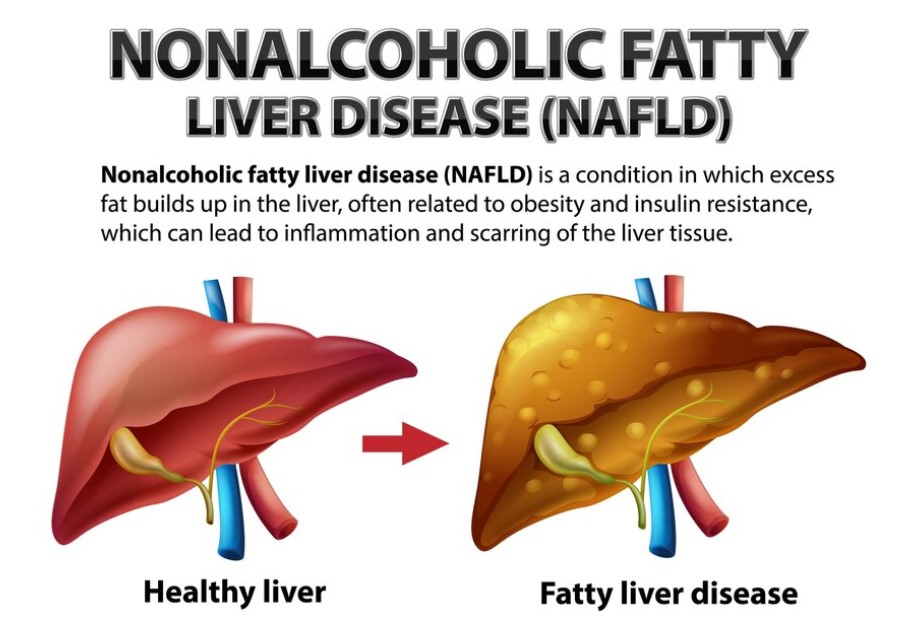
Non-alcoholic fatty liver disease (NAFLD) refers to the accumulation of excess fat in the liver, not linked to alcohol intake. It commonly affects those who are overweight or obese. Although initial stages of NAFLD might not produce significant symptoms, the condition can advance to severe liver issues, including cirrhosis, if it is not properly addressed. This overview covers essential aspects of NAFLD, including its prevalence, risk factors, stages, symptoms, diagnosis, and treatment options.
Prevalence
NAFLD is a condition that can affect individuals of all ages, even children. In India, research indicates a notable prevalence, with around 38.6% of adults and 35.4% of children affected. While age is a key factor in its development, genetics can also play a role in increasing susceptibility.
Risk Factors for NAFLD
The main risk factors for developing NAFLD include:
- Being overweight or obese
- Type 2 diabetes
- Insulin resistance
- Hypertension
- High cholesterol levels
- Metabolic syndrome
- Age over 50
- Smoking
However, it’s important to note that NAFLD can occur even in individuals who do not exhibit these risk factors.
Stages of NAFLD
NAFLD typically progresses through four stages:
- Simple Fatty Liver (Steatosis): In this stage, fat accumulates in the liver cells, often without noticeable symptoms, and is usually discovered incidentally.
- Non-Alcoholic Steatohepatitis (NASH): This stage is characterized by liver inflammation and is more severe than simple steatosis.
- Fibrosis: Inflammation over time leads to the development of scar tissue in and around the liver, while liver function remains relatively intact.
- Cirrhosis: The final stage, where significant scarring occurs, leading to impaired liver function and a heightened risk of liver failure and cancer.
Symptoms
In the early stages, NAFLD often does not present any symptoms. However, individuals in advanced stages, like NASH or cirrhosis, may notice:
- Severe abdominal discomfort
- Chronic fatigue
- Unexplained weight loss and weakness
- Jaundice (yellowing of the skin or eyes)
- Long-lasting itching
Diagnosis
NAFLD can progress without clear symptoms, making diagnosis important, especially for individuals with risk factors like obesity. Diagnosis may involve:
- Liver function tests
- Imaging techniques, such as ultrasound or MRI
- Liver biopsy
If liver enzymes are elevated or signs of fat accumulation in the liver are detected, it’s crucial to seek medical evaluation to explore the possibility of NAFLD.
Mechanisms of NAFLD
The development of NAFLD involves several mechanisms:
- Initial Lipid Accumulation: A sedentary lifestyle, high-fat diet, obesity, and insulin resistance lead to fat buildup in the liver, referred to as the “first hit.”
- Liver Sensitization: This lipid accumulation primes the liver for further injury, known as the “second hit.”
- Inflammation and Fibrogenesis Activation: The second hit triggers inflammation and fibrosis, with various factors contributing, especially in those with genetic predispositions.
Complications
Complications arising from NAFLD may include cirrhosis and liver cancer, particularly in patients with NASH. Liver transplantation might be required for those with advanced cirrhosis. Additionally, NAFLD increases the likelihood of cardiovascular disease, type 2 diabetes, hypertension, and dyslipidemia, underscoring the need for early detection and management.
Management of NAFLD
Managing NAFLD primarily revolves around lifestyle modifications suitable for all age groups:
- Healthy Eating Habits: A diet rich in whole grains, fruits, vegetables, seafood, beans, and nuts is essential. The Mediterranean diet is particularly beneficial compared to conventional Western diets.
- Weight Management: Achieving and maintaining a healthy weight is crucial. Tailored weight loss strategies should be considered based on individual health needs.
- Regular Physical Activity: Engaging in consistent exercise is vital for improving metabolic health and managing NAFLD.
Treatment Approaches
While lifestyle changes are critical, some individuals may require advanced treatments. Bariatric surgery can be a beneficial option for certain patients, showing promise in reversing NASH and reducing fibrosis. Furthermore, research into pharmacological therapies, such as pioglitazone and vitamin E, has shown effectiveness in non-diabetic NASH patients, indicating potential future treatment avenues.
Future Directions
Emerging pharmacological strategies may focus on addressing the upstream factors contributing to NAFLD. Understanding the genetic factors influencing eating behavior and metabolism could lead to innovative treatments that not only target liver health but also address broader metabolic issues.
Although no specific medication exists for NAFLD, lifestyle changes are fundamental to managing the disease. Weight loss through a balanced diet and exercise is particularly effective in reducing liver fat and improving NASH. Medications can also help manage coexisting conditions such as hypertension, diabetes, and high cholesterol. In extreme cases of cirrhosis, liver transplantation may be necessary.
Conclusion
Awareness of NAFLD’s risks, stages, symptoms, and treatment is vital for early intervention, as untreated NAFLD can lead to severe consequences. By adopting healthier lifestyle practices and following medical guidance, individuals can slow the progression of NAFLD and decrease the likelihood of associated complications. Regular check-ups and proactive management are essential to maintain liver health and overall well-being. For specialized care, consider consulting Dr. Ram C. Soni, a leading gastroenterologist in Faridabad, who can provide expert advice and treatment options.
4o mini



